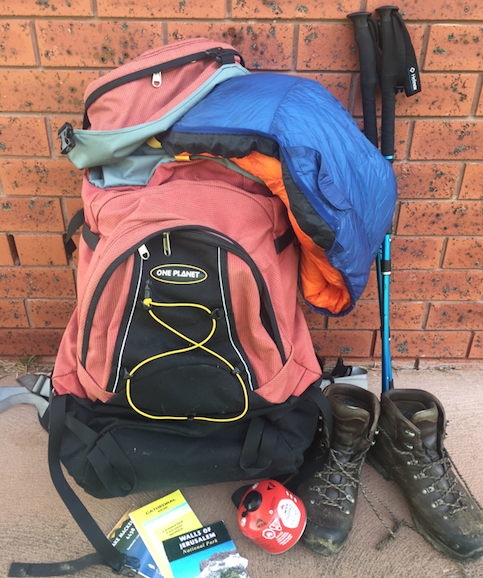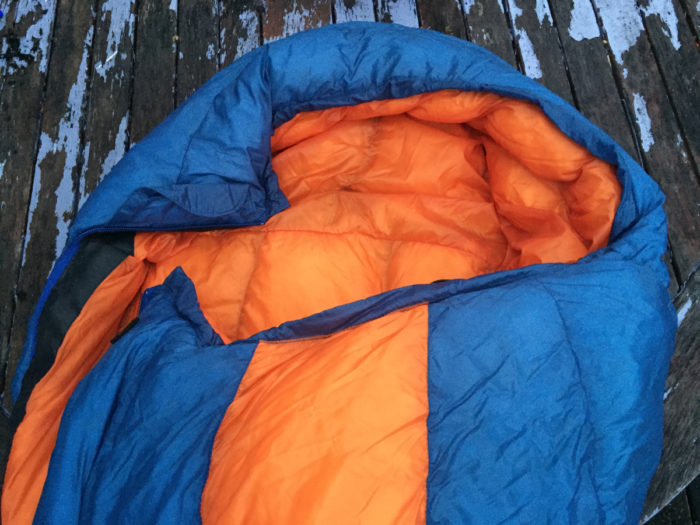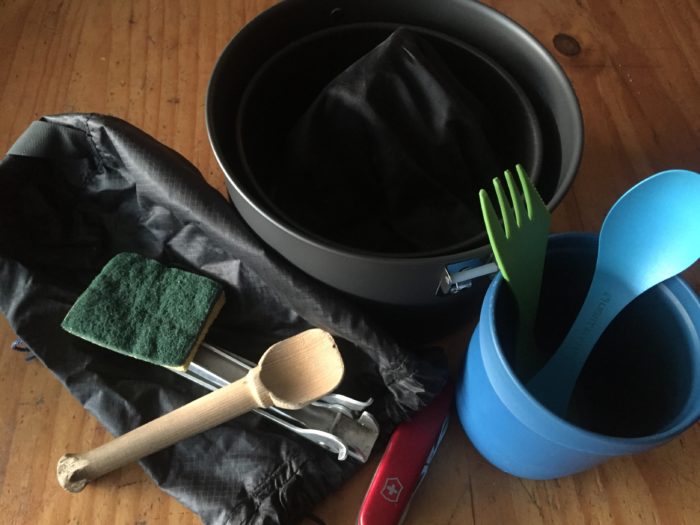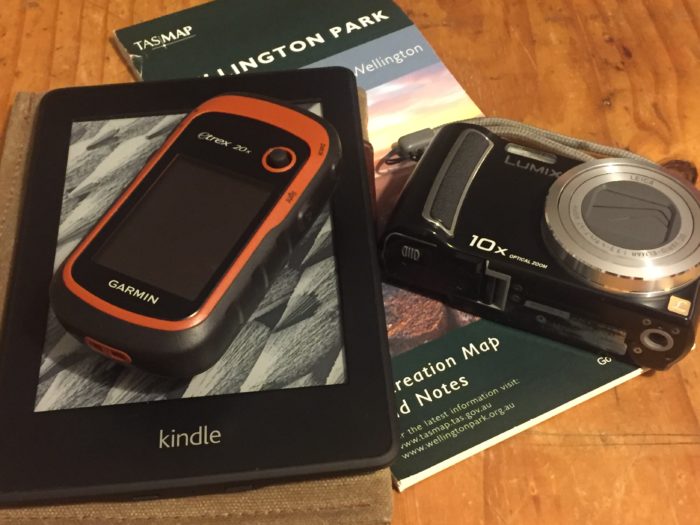Here is a list of gear I use for a multi-day walk. It is not comprehensive as it only includes gear I use. Your requirements may be different to mine.

Main gear
| Check | Gear |
|---|---|
| High quality 4-season tent – including poles and tent pegs. I consider a tent essential for all overnight walking in Tasmania. Others differ on this point, using tarps, or relying on the generosity of people using huts. I used Wilderness Equipment tents for many years, but the fly material failed on both my First Arrow and my Second Arrow. I now use a Hilleberg Nallo 2 as my main tent. If I’m hiking alone I use a Hilleberg Soulo with footprint. | |
| Sleeping bag – A good sleeping bag may be one of the most expensive items of gear in your pack. It really depends on where and when you plan to walk. Here in Tasmania it often snows in the middle of summer so you have to be prepared for all weather. I use a high-quality light-weight One Planet Cocoon -11 for most of the year, and a slightly heavier One Planet Winter Lite -16 sleeping bag for walks in colder, wetter months. The Cocoon weighs less than 1kg (935gms), with the Winter Lite weighing in at under 1.4kg. I carry my sleeping bag in my Sea-To-Summit sil-nylon day pack, inside my pack. | |
| Sleeping mat – essential. I used a self-inflating Thermarest for many years. Great mats, but I now use Exped down-filled mats. | |
| Pack – choosing the right pack is a very subjective exercise. I go for the confidence I have in the quality of a pack over its weight. I use One Planet packs – One Planet McMillan is perfect for long walks – 85L, one main compartment, few pockets, great hip belt, and Australian-made. For shorter trips up to a week I use a One Planet Mungo – 60L, single compartment, same hip belt as my McMillan, and also Australian-made | |
| Hiking boots – Again, this is very subjective. I use Scarpa SL Activs for multi-day walks offtrack or on difficult terrain. I also use Scarpa Deltas where boots are required, but something less hardcore than my SLs will do; and Keen Targhee III shoes for everything else. I buy my Scarpa boots half a size too big, and use the laces to ensure a great fit. I have never had hot spots or blisters in them. My SLs are brilliant. I’m on to my third pair, having worn out two previous pairs. They are quite heavy though, not to mention expensive |

Other essentials
| Check | Gear |
|---|---|
| Waterproof pack liner – essential for keeping the contents of your pack dry. I don’t use a pack cover, as these are likely to snag on scrub. | |
| Silk sleeping bag liner – essential for keeping expensive sleeping bags in good condition, and adds about 5°C to the warmth of the sleeping bag. | |
| Compass – essential to take and also essential to know how to use it | |
| Day pack – on overnight walks I take a Sea to Summit Ultra-Sil Dry Day Pack, 20l capacity, and weighs in at just 90gms. It also doubles as a dry sack for my sleeping bag. | |
| Water bottle – I carry a Kleen Kanteen 800ml for water during the day, and a 2l collapsible plastic bottle for water of an evening. | |
| Rubbish bag – I take a small bag for used tea bags, bar wrappers, etc. Most of the food I take is prepared at home, so is without wrappers that need disposing of. I follow the Leave No Trace philosophy. | |
| Inflatable pillow – For many years I made pillows from the clothes I had with me. I now use a Sea-To-Summit inflatable pillow – just don’t inflate it too high though! | |
| 6m light cord – useful for pack hauling, clothes line, and emergency repairs. It’s also handy for hanging a food bag from a tree. Possums, rats, and other hungry animals can smell your food in your tent and, if they’re hungry enough, they will damage your tent getting to the food. So, if they’re a problem, I hang my food from a tree. | |
| Small shovel – for digging loo holes. I used an iPood! shovel for many years, and I still have it. I now use an ultralight Deuce. | |
| Sun hat and sun glasses – I use Cancer Council sun glasses because they are reliable and cheap. I also use Croakies to hang my sunnies around my neck when I don’t need them on. | |
| Microfibre towel – these are pretty much essential. They are light, dry in next to no time, and come in purple! | |
| Knife – I use a Swiss Army knife. Of course. | |
| LED Torch/LED head torch – I carry both a regular torch (OLight i3E EOS), and a head torch (Petzl Tikka). Both take AAA batteries | |
| Walking poles – I don’t consider these to be essential, but I do have a pair and I use them when I need to. They are not very useful off track unless there is snow around, as the poles assist with balance, but on-track they can be quite useful, making the load on my back feel a little lighter. I use Helinox poles – Ridgeline LBB135s. |

Food and cooking
| Check | Gear |
|---|---|
| Stove – I have used MSR Whisperlite Internationale fuel stoves for over 30 years. I currently have two – a regular Internationale, and a Universal. The Universal has an attachment to take a gas canister. MSR stoves have proved to be totally reliable every time I’ve used them. My Internationale has traveled many 1000s of kilometres, many 100s of kms walking, and in all conditions – beaches to above the snowline. I can’t say that they are the lightest stoves going around, but I have absolute confidence in them. I currently use an MSR Simmerlite. Despite what reviewers say, these stoves do simmer if you’re careful not to over-pressurize the fuel container. And they are lighter than Whisperlites. I also use a windshield around the stove to mitigate the effect of any breeze, and to help isolate the fuel bottle from the hot stove. | |
Pots – For many years I have used 2 regular Trangia pots – they are light and my stove fits inside perfectly. Unfortunately, the non-stick surface is delaminating. So I now use:
My MSR Simmerlite stove fits inside the Alpha Pot perfectly, along with matches and the stove pump. The Alpha Pot fits perfectly inside the Trangia pot, making for a very compact, hard wearing, and light cooking setup. |
|
| Cooking and eating utensils – To aid cooking, I have a small wooden spoon to stir food, and a pot holder. For eating with, I take a spork, a cup, and sometimes I take a plastic bowl. When I’m walking I store my silk sleeping bag liner, in it’s small bag, in my cup. | |
| Scourer – I take a regular scourer, cut in half, to wash with, and a very small micro fibre towel to dry washed utensils and pots. |
Clothes
Planning what clothing to take on a walk is important. Keeping weight down while having enough clothes for the entire trip is difficult at times.
Layering clothes is a good philosophy. I choose clothing made from lightweight, fast-drying materials. I used to prefer merino for my thermal layer, but I now use either a silk and merino blend (the fabric is strengthened by the silk) or a recycled polyester and merino blend. I use polar fleece for warm layers. In Tasmania ensure you carry clothes for all weather, no matter what the season.
I generally wear a light short-sleeve fast-drying t-shirt (silk and merino blend) and shorts during the day. For layering during the day I use a Mountain Designs merino blend thermal as a base layer, and the brilliant Kathmandu Trailhead vest as an outer-layer. I am really pleased Kathmandu are making quality walking gear again. If it’s really cold I use a Macpac Tui fleece pullover instead of my vest.
I take one spare set of clothes. Generally one change of underwear is enough, and two spare pairs of socks are good – one to wear around camp in the evening after the day’s walk, and one dry pair to use in case the pair I’m walking in gets wet.
The warm-wear I use around camp include a thermal top, a Mont Argo jacket, and a Macpac Uber Light down jacket.
| Check | Gear |
|---|---|
| Rain shell – Given Tasmania’s weather, a high-quality rain shell is essential at all times. These are expensive, but keep an eye on the sales at various outdoor gear stores and you can pick up a good shell for quite a bit off the regular price. I use a One Planet Torrent – this is a mid-thigh length jacket that is perfect for hiking in. DWR treatment is necessary now and then to ensure the jacket continues to repel water. | |
| Beanie – Essential. Either wool or microfibre are good. I use a silk and merino blend beanie for walking in, and a heavier wool beanie in the evening. | |
| Gloves – Essential. I use a cheap Thinsulate pair, and a light waterproof pair if it is cold and wet. | |
| Thermals – Essential. I used to use pure merino, but I have found merino is hopelessly fragile. All my expensive merino thermal tops are a mass of holes. And that’s after having hand washed each, using only Lux pure soap flakes. I now use a couple of mixes: merino and silk (Klattermusen), and merino and nylon (Kathmandu, Mountain Designs). |

Electronics
| Check | Gear |
|---|---|
| Camera – don’t forget a fully charged spare battery. | |
| GPS – along with a map and compass, I consider these essential. | |
| EPIRB/PLB – essential for off-track and remote walking, and can be hired from Service Tasmania for $40 a week. I ended up buying one – a KTI Safety Alert GPS PLB. These have a 10 year battery life, are easy to use, made in Melbourne, and are light. | |
| Kindle – a good solution to having reading material for a cold, wet, tent-/hut-bound day | |
| Mobile phone – I don’t carry a mobile phone with me on multi-day walks |
Health and safety
| Check | Gear |
|---|---|
| First aid kit – I am not a surgeon, therefore there is a limit to the level of first aid I can administer on a bush walk. I should, however, be able to treat minor and non life-threatening injuries and ailments, as well as snake bite. These include scratches, minor burns, sprains, blisters, and maybe minor breaks depending on where they are. With this in mind, I carry a first aid kit to accommodate these. I may include a list of what’s in my kit if people request that. | |
| Sun screen – In terms of personal discomfort and more serious issues down the track, when it comes to sunburn prevention is better than than mitigation. In Tasmania the sun is particularly strong, so I consider sun screen to be essential. SPF 50+ is the one to look for, although SPF 30+ is also good. I have found that Hamilton is a great brand to use, but difficult to find. I also use Cancel Council brand – this is easier to find and pretty reliable. | |
| Dental hygiene – toothpaste and a tooth brush. Some people cut their brush handle down. I don’t. | |
| Towel – I use a microfibre towel. It soaks up amazing amounts of water and dries quickly. Microfibre towels are also very light, cheap, and pack away in next to no space. | |
| Insect repellent – Mosquitoes and sand flies are very active in parts of Tasmania, mainly during Summer and early Autumn, so it’s a good idea to either carry an insect repellent, or wear long trousers and a long sleeve shirt. There are areas in the state where Ross River fever is prevalent, so avoid mosquito bites where possible. Sand flies are an issue on the West Coast and South Coast. An application of insect repellent helps in both cases. Here is a link to a site with a bunch of other remedies. | |
| Toilet paper – There are toilets on some Tasmanian tracks, but toilet paper is not always supplied. Ensure you have enough toilet paper with you to last the entire walk. I have had to ask for extra in the past because I miscalculated. And, if you are sharing toilet paper, the Tragedy of the Commons comes in to play… |